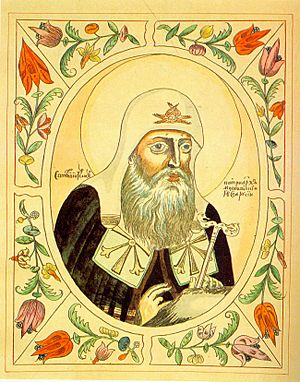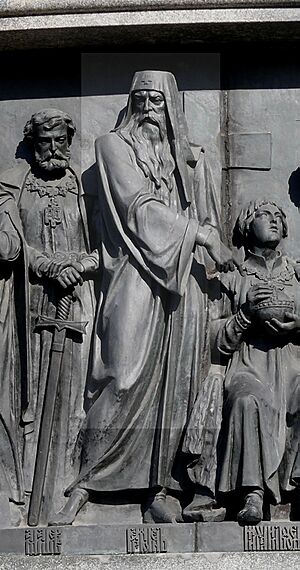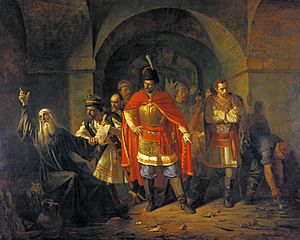Patriarch Hermogenes of Moscow facts for kids
Quick facts for kids Hermogenes |
|
|---|---|
| Patriarch of Moscow and all the Rus' | |
 |
|
| Church | Russian Orthodox Church |
| See | Moscow |
| Enthroned | 1606 |
| Reign ended | 1612 |
| Predecessor | Ignatius |
| Successor | Filaret |
| Personal details | |
| Born | c. 1530 Russia |
| Died | 17 February 1612 |
| Buried | Dormition Cathedral, Moscow |
Hermogenes (also known as Germogen) was a very important leader of the Russian Orthodox Church. His birth name was Yermolay. He lived from before 1530 until February 17, 1612. From 1606, he served as the Patriarch of Moscow and all the Rus'. This means he was the head of the Russian Orthodox Church. Hermogenes played a key role in ending a difficult period in Russian history called the Time of Troubles. The Russian Orthodox Church recognized him as a saint in 1913.
In 1589, a special church meeting called the Holy Synod created the position of Patriarch in Moscow. At this meeting, Hermogenes was chosen to be the Metropolitan of Kazan. A Metropolitan is a high-ranking bishop. For the next 20 years, he became well-known for helping many Muslim Volga Tatars become part of the Eastern Orthodox Church.
In 1606, a ruler known as False Dmitry I called Hermogenes to Moscow. He wanted Hermogenes to join a new council called the Governing Senate. There, Hermogenes found out that the tsar planned to marry a Roman Catholic woman, Marina Mniszech. Hermogenes strongly spoke out against this marriage. Because of his strong opinion, he was sent away from the capital city. However, he returned with great respect a few months later. This happened after the false tsar was removed from power, and Patriarch Ignatius also left his position.

Contents
Becoming Patriarch of Moscow
The new tsar, Vasily IV, helped Hermogenes become the Patriarch of Moscow and all the Rus'. Metropolitan Hermogenes was chosen for this top church position. On July 3, 1606, he was officially made Patriarch. This ceremony took place at Moscow's Dormition Cathedral.
During the ceremony, Metropolitan Isidore gave the new Patriarch a special staff. Tsar Vasily also gave Hermogenes gifts: a beautiful panagia (a necklace with an icon), a white klobuk (a special hat), and another staff. Following an old tradition, Patriarch Hermogenes entered the city riding on a donkey. During Tsar Vasily's rule, Hermogenes generally supported the tsar's efforts to bring peace to the country. He also strongly condemned Ivan Bolotnikov and his army.
Standing Strong During the Time of Troubles
- Further information: Time of Troubles
The Time of Troubles was a very difficult period in Russian history. It was a time of great political crisis and chaos. When Tsar Vasily was removed from power, Polish forces took control of the Moscow Kremlin. Hermogenes bravely stood against their plans. He did not want Wladyslaw IV to become the Russian tsar unless Wladyslaw converted to the Orthodox faith.
Even when some powerful nobles threatened him with knives, Hermogenes refused to sign any requests to the Polish king. By doing this, he stopped Wladyslaw from being crowned tsar.
In December 1610, Hermogenes sent letters to many Russian towns. He urged the people to rise up and fight against the Poles. When a volunteer army, led by Prokopy Lyapunov, finally neared Moscow, the Poles tried to make Hermogenes condemn this army. But Hermogenes bravely refused. Even though he was threatened with death, he spoke out against the Roman Catholics and showed his support for Lyapunov.
After this, Hermogenes was arrested and imprisoned in the Chudov Monastery. While there, he heard about a new volunteer army being gathered by Kuzma Minin and led by Prince Pozharsky. He gave his blessing to both of them. Sadly, the patriarch was then beaten and starved to death.
His Death and Lasting Impact
Hermogenes was first buried in the Chudov Monastery. But in 1654, his body was moved to the Moscow Dormition Cathedral. In 1913, during repair work at the Chudov Monastery, what were believed to be his remains were found.
That same year, Russia was celebrating 300 years of the Romanov Dynasty. Because of his heroic actions, Hermogenes was officially recognized as a hieromartyr (a saint who was also a martyr). His remains were then moved to the nearby Dormition Cathedral.
The Russian Orthodox Church remembers him on two special days. They celebrate him on February 17, which is the day he died. They also remember him on May 12, the day he was recognized as a saint.
See also
 In Spanish: Hermógenes de Moscú para niños
In Spanish: Hermógenes de Moscú para niños


